"On a cosmic scale, our life is insignificant, yet this brief period when we appear in the world is the time in which all meaningful questions arise." -Paul Ricoeur
Ask anyone who's looked up at a dark sky on a clear, moonless night, and you'll immediately hear tales about how incomprehensibly vast the Universe is.
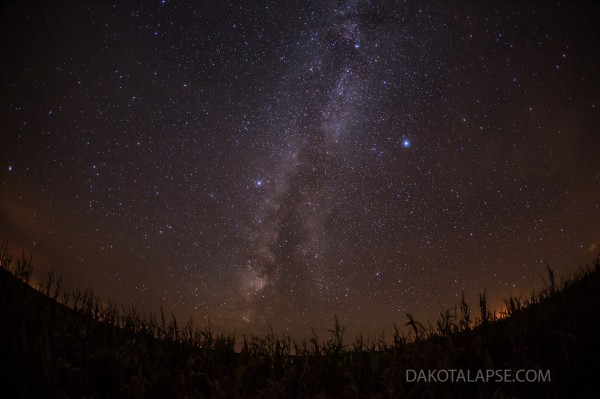 Image credit: Randy Halverson, flickr user dakotalapse, from http://dakotalapse.com/.
Image credit: Randy Halverson, flickr user dakotalapse, from http://dakotalapse.com/.
But what you're looking at isn't much of the Universe at all. In fact, practically every point of light you see, including the vast swath of stars too dim to individually resolve, comes from within our own Milky Way galaxy. As we know from generations of telescopes, observatories, observations, as well as physicists and astronomers, the Universe goes far beyond that.
 Image credit: NASA, ESA, R. Windhorst, S. Cohen, and M. Mechtley (ASU), R. O'Connell (UVa), P. McCarthy (Carnegie Obs), N. Hathi (UC Riverside), R. Ryan (UC Davis), & H. Yan (tOSU).
Image credit: NASA, ESA, R. Windhorst, S. Cohen, and M. Mechtley (ASU), R. O'Connell (UVa), P. McCarthy (Carnegie Obs), N. Hathi (UC Riverside), R. Ryan (UC Davis), & H. Yan (tOSU).
There are hundreds of billions of galaxies (at least) out there in our observable Universe, spread out, from our vantage point, over a sphere some 46 billion light-years in radius.
If we were to look at it, as human beings, we'd be limited by the biology of our eyes. Very well adapted for seeing in well-illuminated conditions, we'd do somewhat less well in intergalactic space; we'd only be able to see the closest and brightest of all light sources, which would most likely limit us to only a few dozen galaxies if we were plunked down in a random location.
 Image credit: Knut Skaar of http://knutsastronomy.blogspot.com/, of Messier 109.
Image credit: Knut Skaar of http://knutsastronomy.blogspot.com/, of Messier 109.
As it is, we're within our own galaxy, and so have thousands upon thousands of foreground stars that we have to ignore when we look deep into the Universe. We also are familiar with using tools like telescopes and/or cameras -- required to see even nearby, bright galaxies like Messier 109, above -- to help enhance our understanding of what's out there.
No wonder so many of us have dreams of voyaging across the Universe, seeing what's out there, of all the galaxies and how they clump and cluster together, of the different forms they take, and of what such an adventure would look like.
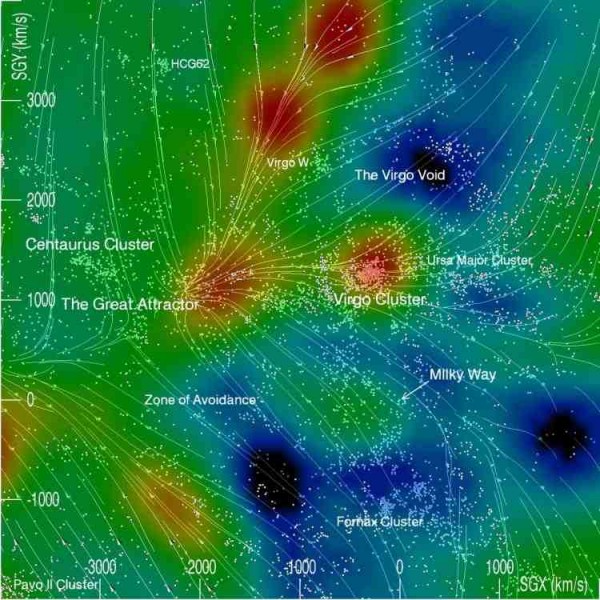 Image credit: Cosmic Flows Project/University of Hawaii, via http://www.cpt.univ-mrs.fr/.
Image credit: Cosmic Flows Project/University of Hawaii, via http://www.cpt.univ-mrs.fr/.
Recently, the Cosmic Flows Project has put together a stunning video (narrated in French) that's a 17-minute tour through the local Universe within 300,000,000 light-years. It's a remarkable look at not only our Milky Way, our local group, our nearest supercluster (the Virgo supercluster, of which we're on the outskirts, and which contains about 100,000 galaxies), and the largest superclusters and voids found nearby! When you've got the time, you definitely want to watch the whole thing.
But you might look at this and wonder just how we figure this out. From our vantage point here on Earth -- or even in space from someplace within our Solar System -- there's a lot of information to filter through and figure out. The simplest thing you can do actually gets you very far: remember Hubble's Law, or the fact that not only is the Universe expanding, but the distance a galaxy is from us is directly proportional to its recession speed.
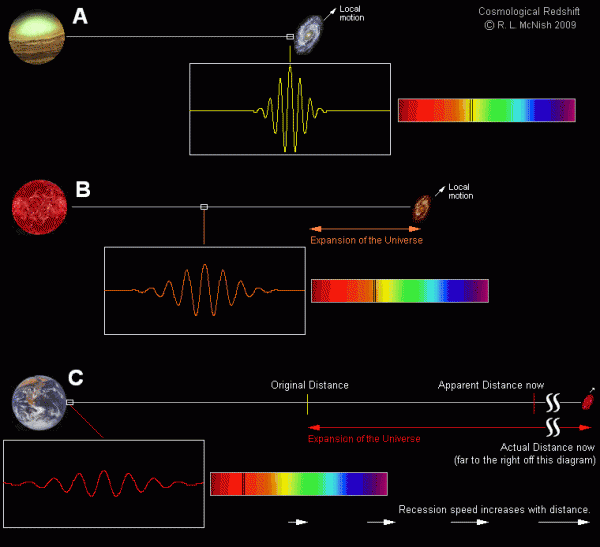 Image credit: Larry McNish of RASC Calgary Centre, via http://calgary.rasc.ca/.
Image credit: Larry McNish of RASC Calgary Centre, via http://calgary.rasc.ca/.
It turns out that redshift is actually a somewhat easy property of a galaxy to measure, so if you know Hubble's law, you can infer how far away that galaxy is.
Well, kind of. Hubble's Law gives a very good approximation for distances on average, on large scales. But Hubble's law doesn't account for all of an object's redshift. There's also the very minor issue (that's sarcasm) of all the other matter in the Universe, and the gravitational effects it's had over the past 13.8 billion years.
Matter has this annoying property that it clumps and clusters together, and that's because gravitational attraction causes it to move. Don't get me wrong, this is great for lots of things, but it's not great when you're trying to figure out how distant an object is based on its motion!
It creates distortions along the line-of-sight, known as redshift-space distortions.
As you can see, on the left, these distortions create apparent lines or streaks that point radially towards you. We call these features Fingers of God. These happen because galaxies that are clustered together move more rapidly, both towards and away from the center of the cluster, which spreads them out in redshift.
There's also a less noticeable effect, where clusters move relative to one another and fall into superclusters and filaments; these actually have the reverse effect on larger scales, creating flatter features on very large scales. There are some who call this the Kaiser effect (after Nick Kaiser), but I've always called them Pancakes of God.
So, how do we overcome these redshift space distortions? Believe it or not, this is one of the times where simulations have helped us tremendously! Thanks to the way that structure forms over the history of the Universe, from its gravitational evolution, we can figure out exactly how, on all distance scales, clustered objects translate from redshift space, which is easy to measure, into real space, which is the Universe we actually live in.
At this point, we understand clustering in our Universe -- as well as the dark matter and dark energy that it's dependent on -- to make this transformation with incredibly high degrees of confidence. So sure, we start in the same place: we measure the redshift of galaxies and plot them out accordingly.
But then we use all the things we know about mass and matter and gravity to understand how these galaxies have clustered together, and to map out -- to the best of our abilities -- their peculiar velocities, or their velocity with respect to the Hubble flow. By subtracting those peculiar velocities out, we can get estimates for their real-space positions, and hence, for how far away in each direction each galaxy is.
So what would flying through the Universe -- the real space Universe -- actually look like? Not to human eyes, but to our eyes as they'd be if we had pupils the size of giant telescopes? Well enjoy this brilliant video by Miguel Aragon, Mark Subbarao and Alex Szalay of the Sloan Digital Sky Survey that puts it all together!
And that's just a tiny glimpse into what the Universe really looks like!

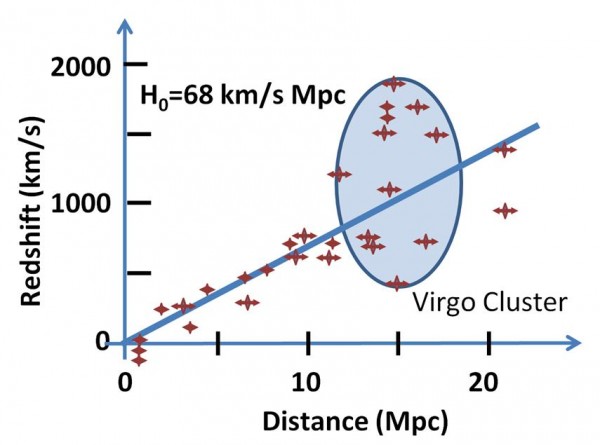
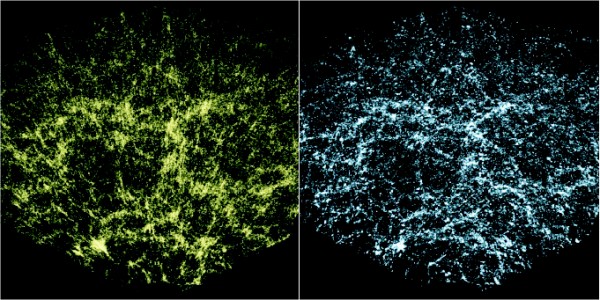

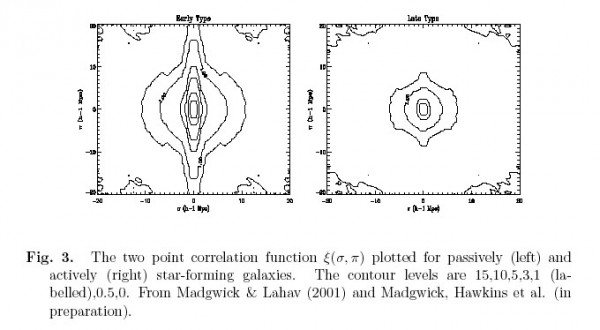


The Cosmic Flows video (which I've seen before) is fascinating, but that SDSS fly-through is stunningly beautiful! I started to get the same feeling I get when I stare at the Hubble Deep Field.
Thanks for sharing.
Good blog. I watched videos. Wow. Great stuff. Thanks to all.
test
The narrator is speaking English, she just has a French accent.
Thank you Ethan, I understand the Cosmic Flows video much better now!
I've read that if you picked a random spot in the Universe, the odds are you wouldn't be able to see a single galaxy or star with the naked eye. (David Deutsch said it, I think.)
" if you picked a random spot in the Universe, the odds are you wouldn’t be able to see..."
well.. if it's truly random then that spot could be in some other galaxy and you would see more or less the same thing you see from earth. If you happen to find yourself in intergalactic space, again depends where. If you're in some galaxy cluster, you would see some galaxies as point sources like stars. If you happen to land in a particularly big intergalactic void, then yes.. all you would see is nothing.
But such a big generalization, that the chances are you won't see anything, is wrong IMO.
"Hubble’s Law, or the fact that not only is the Universe expanding, but the distance a galaxy is from us is directly proportional to its recession speed."
I have a question that may make no sense whatsoever since my astrophysics degree got lost in the mail...
As I understand it: Galaxy A is receding from us at a certain rate. Galaxy B, which is twice as far away as Galaxy A, is receding from us at twice the rate of Galaxy A. Is the space between Galaxy B and Galaxy A expanding at a faster speed than the space between us and Galaxy A? Or does it seem like it's going faster because there's twice as much expanding space between us and Galaxy B, and it just looks faster from our perspective? Or is it all the same thing because of Relativity?
@9 william
the second one. there is twice as much. and vice versa. to someone in galaxy B we would appear to be moving away faster than galaxy A which is nearer to it. Basically every unit of space is expanding. everything appears to be moving away from everything else.
Mark,
I've heard that before, too.
It's quite wrong. It's true that the Universe is highly clustered into clumps and filaments, but -- if you removed our entire galaxy -- we'd be able to see a large number of galaxies. Andromeda and Triangulum would be the brightest, and other local group galaxies would be prominent as well, but there would also be many galaxies from beyond the local group, including at least two I can think of (including one of our Messier Mondays) more than 10 million light years distant.
So, there are plenty of locations from where not a single galaxy would be visible, but if you plunked yourself down at a random location, far fewer than 50% of those places would have that property.
So there you have it. The universe looks like--a mammogram!
This is why I believe in a Supreme Being
re #13 is it because you don't understand and do not wish to know your knowledge is limited and work to reduce the limitations. Hence will decide to dump the idea "I have no idea" into "Goddidit" and therefore drop the idea that maybe you could find out about things if you spent a little effort?
What an of thing to say, when nothing here presents evidence for such a being.
And thank you to my tablet for changing 'odd' to 'of'. I should have caught that.
@ Sinisa;
Thanks! That's what I was thinking but as I said, my astrophysics degree got lost in the mail. ;)
Has the science of cosmology and astrophysics become absolutely positively 100% accurate were the theories are concrete undeniable evidence? While Classical Physics and Quantum Mechanics still duke it out? Which to give super detailed reports about measurements would be required. Personally, I think not, and don't buy the hype! Scientists want to pretend they have all the answers. I seriously doubt they understand the question!
It would be more than advisable to get acquainted with the Electromagnetic theory; "Electric Universe" for short. It answers more questions than the gravitational model and will ultimately replace Newtonian physics as well as much of Einstein's assumptions on how our universe operates. Just Google "Electric Universe Theory" and be prepared to be amazed...
Re #19: How are classical physics and quantum mechanics "duking it out"? If you mean that our two main theories in physics, general relativity and the standard model are incompatible, then yeah, we know that. However, they are hardly "duking it out". They are both right, just there are domains in which they give different answers.
It's a similar situation as Newtonian physics. Newtonian physics is perfectly right as long as you stay within its domain. We've launched interplanetary probes and made moon landings using only Newtonian physics. It works well within its proscribed domain. Similarly, GR and SM both work well within their domains, which in the case of GR includes just about any cosmological observation.
Obviously, both GR and SM cannot be absolutely complete. However, any new theory to replace them must yield predictions in line with them for observations within their domains. That is, we can explain the observations of cosmology with GR, and even when it's replaced, the new theory must give the same predictions. So yes, we are pretty confident in our cosmological models, at least unless new data becomes available. If so, then we would change the model.
Joe, that crock has been peddled here before.
We were amazed.
Just not in the way you'd hoped...
@ blade:
If you think scientists pretend to know all the answers, then you're only listening to pretend scientists.
@ Joe:
EU proposes that the sun is powered not by fusion, but by an interstellar DC current. Test this hypothesis. Calculate the minimum current strength required to explain the observed output of the sun, assuming a perfect conversion of input energy to output energy. Then calculate the strength of the induced magnetic field of such a current at 1 AU. Hint: It will be much stronger than the earth's magnetic field.
Then step outside with a compass and prove the theory false.
I've heard of Electric Boogaloo and Electric Avenue, but Electric Universe is new. How large a surge protector is needed?
I'm gonna take you to Electric Avenue.
Cool article and interesting to think about. It might seem bizarre now, but with quantum processors we will eventually accomplish some incredible things, like run computer simulated universes (as modeled above) that are indistinguishable from our own “real” universe, even complete with simulated minds. There is even a new book out that discusses the implications of all this (i.e., “On Computer Simulated Universes”) and introduces concepts such as the 'Computer Simulated Universes Evolutionary Hypothesis'. With many active simulations, there would be a wide range of physical properties differing from universe to universe. Universes with more positive physical traits to support life would produce better environments for more advanced civilizations to evolve to the point where they themselves would create their own computer simulated universes. And this process would continue. So over a long period of time, universes would evolve with the physics more favorable for life. The book argues that universes, over time, might have been naturally selected for particular physical properties, with an end result of creating more and more habitable and longer-lived universes. This line of reasoning explains how the laws of physics might actually evolve relying on a process somewhat similar to human or species evolution.
i love this article because it has a lot of diagrams that show us what the universe is like for real and i especially like the graph aswell i think people should use this article more often because the universe is an interesting thing to know. i i find it interesting because everything on here is what i am looking for
bellooo i love universe hence i love these pictures